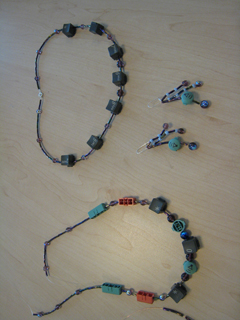While at VoiceCon 2008, I met with Marie Wold, the CFO and President of the European enterprise mobility startup, OnRelay. Founded in 2000, OnRelay has been positioning the MBX appliance as a mechanism to eliminate desktop telephones. In fact, it was their creative press release about how 25 million deskphones and the network infrastructure and cabling to be purchased by companies in 2008 are likely to become waste, that got me over the 'should I / shouldn't I' hump. Kudos to Iris and the PR team for that great pitch.
 In fact, here is suggestion on jewelry that can be made from old desktop phones. Instead of jewels, they've got the digit chicklets and other components.
In fact, here is suggestion on jewelry that can be made from old desktop phones. Instead of jewels, they've got the digit chicklets and other components.
The MBX is well beyond emergence and strongly into production since the company's founding in 2000. Certified with Cisco, Nortel, Siemens and Avaya, the MBX is a proven solution to enabling enterprise mobility. Each of these vendors have implemented their own Fixed-Mobile Convergence solutions (some through acquisition), but the MBX offers a cross-brand solution not unlike enterprise-wide voicemail systems being independent from the telephony brand.
At the heart of the MBX is the TINP (Telephony Inter-Networking Protocol) which tightly couples a client on the mobile device (very small footprint) with the appliance connected to the PBX. The service is not available on RIM, PalmOS, Motorola or Apple devices which are significant share of the enterprise market. Instead, they rely on the Nokia S60 v2 and v3, and Microsoft Windows Mobile 6 to empower their customers.
With approximately 100 employees in Europe, profitable operation in 2006 and the soon-to-be-opened USA office (Washington DC area), the company also announced a hosted offer for mobile operators. Building up the North American channels (IBM, Dimension Data and Westcon have agreements) and sales resources in competition with DiVitas, Tango Networks and Agito will help deliver on the promise of the desktop-less, fully mobile enterprise.







